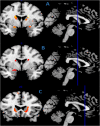Volumetric Brain Changes in Older Fallers: A Voxel-Based Morphometric Study
- PMID: 33777908
- PMCID: PMC7987921
- DOI: 10.3389/fbioe.2021.610426
Volumetric Brain Changes in Older Fallers: A Voxel-Based Morphometric Study
Abstract
Background: Falls are frequent and severe in older adults, especially among those with cognitive impairments due to altered motor control. Which brain areas are affected among fallers remains yet not elucidated. The objective of this cross-sectional analysis was to determine whether the history of falls correlated with focal brain volume reductions in older adults.
Methods: Participants from the MERE study (n = 208; mean, 71.9 ± 5.9 years; 43% female; 38% cognitively healthy, 41% with mild cognitive impairment and 21% with dementia) were asked about their history of falls over the preceding year and received a 1.5-Tesla MRI scan of the brain. Cortical gray and white matter subvolumes were automatically segmented using Statistical Parametric Mapping. Age, gender, use of psychoactive drugs, cognitive status, and total intracranial volume were used as covariates.
Results: Fifty-eight participants (28%) reported history of falls. Fallers were older (P = 0.001), used more often psychoactive drugs (P = 0.008) and had more often dementia (P = 0.004) compared to non-fallers. After adjustment, we found correlations between the history of falls and brain subvolumes; fallers exhibiting larger gray matter subvolumes in striatum, principally in bilateral caudate nucleus, than non-fallers. By stratifying on cognitive status, these neuroanatomical correlates were retrieved only in participants with MCI or dementia. There were no correlations with the subvolumes of white matter.
Conclusion: Older fallers had larger subvolumes in bilateral striatum than non-fallers, principally within the caudate nucleus. This suggests a possible brain adaptative mechanism of falls in people with neurocognitive decline.
Keywords: accidental falls; brain; brain mapping; motor control; older adults.
Copyright © 2021 Le Floch, Ali, Asfar, Sánchez-Rodríguez, Dinomais and Annweiler.
Conflict of interest statement
The authors declare that the research was conducted in the absence of any commercial or financial relationships that could be construed as a potential conflict of interest.
Figures

References
-
- Albert M. S., DeKosky S. T., Dickson D., Dubois B., Feldman H. H., Fox N. C., et al. (2011). The diagnosis of mild cognitive impairment due to Alzheimer’s disease: recommendations from the national institute on aging-Alzheimer’s association workgroups on diagnostic guidelines for Alzheimer’s disease. Alzheimers Dement 7 270–279. 10.1016/j.jalz.2011.03.008 - DOI - PMC - PubMed
LinkOut - more resources
Full Text Sources
Other Literature Sources

